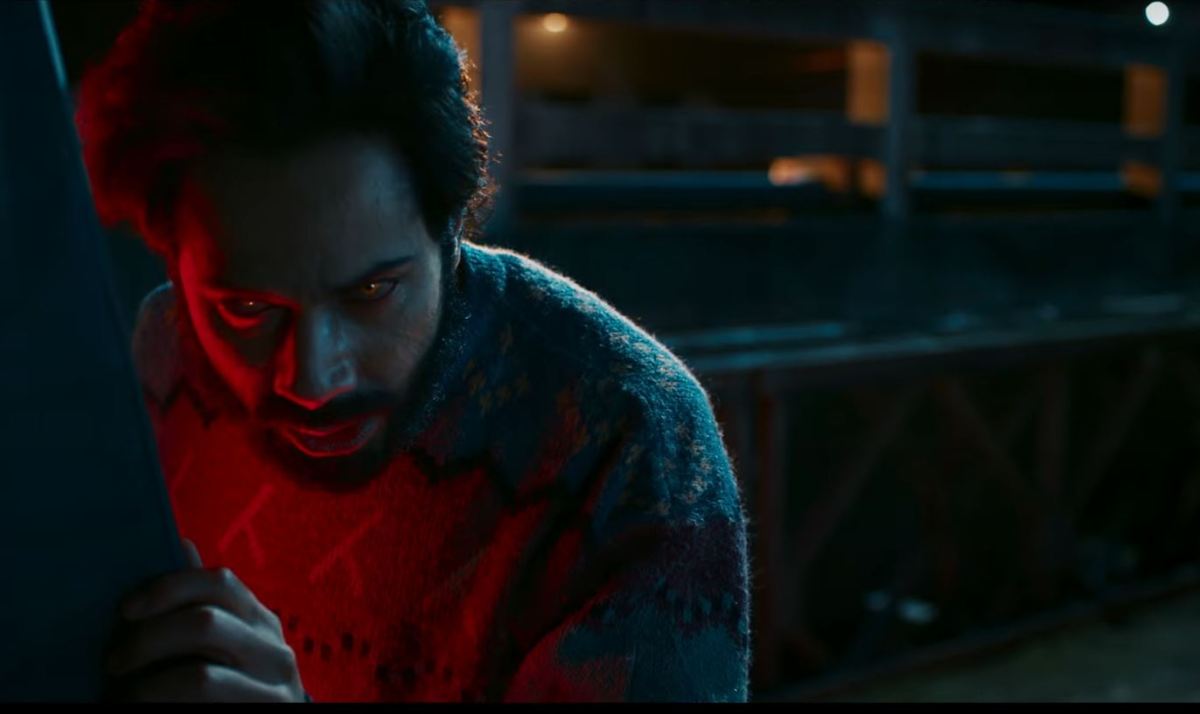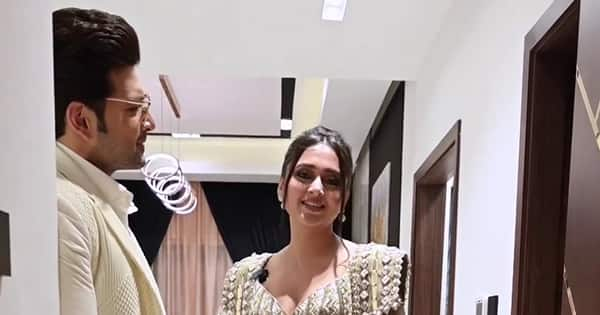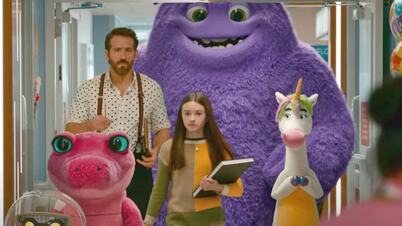Varun Dhawan comes into his own as director Amar Kaushik’s bhediya (wolf). Kriti Sanon, too, leaves her mark in a pivotal, non-glamorous avatar.
Rating: 3 / 5

Imitation is the best form of flattery. For long, Indian cinema beat this line to justify their Western inspiration while making a similar desi film. It is hard to toe this line in the age of social media, trolling. The moment Bhediya [2022] was announced, social media swung into action writing off the film as a sasta (cheap) desi werewolf. Well, given our cinema’s history, and the impact of American, other Western cinema, we have been blindsided to the fact that Hollywood, too, has imported the wolf man legend.
The idea dates back to ancient Mesopotamia in the epic of Gilgamesh. Greek mythology has its own such legend in Lycaon. It then spread to Nordic cultures too. Hollywood tapped into this ancient legend and made The Wolf Man [1941] paving the way for many such stories in Hollywood and around the world. A folklore that was foreign is now presumed to be American. Hollywood though deserves credit for popularizing the mythology to the point of literally owning it.
The challenge for Jio Studios, Maddock Films was to ensure that their Bhediya is not labelled as bhed chaal [blind following].
Director Amar Kaushik and writer Niren Bhatt pick a desi folklore from Arunachal Pradesh to tell their creature comedy. They claimed that Yapum (wolf man) or Yapun is a legend in the picturesque state of Arunachal Pradesh. We confess to not knowing about it. Well, if most of us don’t know about our North Eastern states, how can ignorant souls, including yours truly, be expected to know about their folklore?
Bhediya subtly highlights the cultural divide. It picks on North India, Delhi here, to expose the stereotypes. Bhaskar [Varun Dhawan] is a desperate Delhi business executive who has risked his personal property to bag a road project in far off Arunachal Pradesh. The big urban dream though requires the road to be constructed on a forest land. The stakes are too high to let go of this plum opportunity. So, Bhaskar shamelessly sells the urban city dream to local corrupt civil and forest officials in Ziro, Arunachal Pradesh. Things though turn awry as a mystical wolf bites Bhaskar in the bum soon turning him into one.
Déjà vu but Kaushik and Niren Bhatt do well to add a desi tadka to a possibly done-to-death legend. The duo bank on desi tradition but also cleverly adapt the legend to modern day sensibilities. They also incorporate certain Bollywood tropes to tell their creature comedy. At the heart of this folklore though lies an important message. How can an Amar Kaushik horror/creature comedy not have one?
If it was feminism in Stree [2018], body/color shaming in Bala [2019], Kaushik’s Bhediya [2022] digs it claws into the man vs nature conflict. There’s seldom a contest in a populous world. That is where the reel tries to restore some parity.
Kaushik and Bhatt smartly create a protagonist who cares two hoots for nature. He believes that youth today wants Netflix over nature, iPads over pedh (tree). He wants to make the shift from Jamnagar to GK [Greater Kailash, posh Delhi suburb] in quick time. This line reveals Bhaskar’s greed and desperation to move up in life. The Delhi man sounds more like a Wolf of Wallstreet or Dalal Street. The big bucks though will only come with the construction of the road.
The elderly Ziro tribals bring out their weapons at the mere mention of culling the forest. Bhaskar then woos the tribal youth to convince their elders. “Aapke Ziro mein road banega, tab aapka Ziro no.1 banega,” says Bhaskar. All hail ‘Hero No.1 Govinda’.
After enduring tough last few years, Dhawan has found his mojo again in a role, style/tone that is his comfort zone. There is no needless melodrama as Dhawan appears to have stuck to his director’s diktat. The physicality is natural to him, but Dhawan does well to make the viewer empathize as well as be amused by Bhaskar. Hey, wasn’t Govinda named Bhaskar in Partner (2007)? Hang on, we are not starting another needless Varun aping Govinda talk. Dhawan is very much his own man as the bhediya. He howls and prowls by the night. Come morning, he embarrassingly holds onto to his torn designer under wear to the sound of Jungle Jungle Baat Chali Hai [jingle from the dubbed Hindi cartoon of Rudyard Kipling’s Jungle Book]. Clearly, this visual is no ‘edkum cozy’ like the popular underpants brand that Dhawan once endorsed. Bhediya reimposes fans’ faith in Dhawan. More importantly, the actor, too, would take confidence from this fine show.

Another Maddock film for Kriti Sanon. We feared whether it would become an overkill. There is some substance to Sanon’s character Anika, who is perhaps the lone veterinarian in Ziro town. Hindered by the script, Sanon makes the most of her screentime. The new hairdo, simple costumes, the unexpected hesitant tone reveal an altogether new side to Kriti Sanon. And that is so refreshing.
Abhishek Banerjee bears the same character name as in Stree [2018]. Bhediya’s Janardan is Bhaskar’s cousin. He is a stickler for Hindi, maybe contrived in his nationalism. The Indian Administrative Service aspirant is less confident of cracking the IAS exams, but he isn’t afraid to spit out his stereotypes about North East Indian and people of Mongoloid features.
Kaushik builds his edgy humour around these stereotypes. A Janardan epitomizes the North Indian who is totally clueless about India’s North East, that is often clubbed into one by the rest of India. Look we’ve used North Indian because Kaushik’s principal characters are one. In an opening scene, Janardan mixes the capital cities in North East Indian states only to be corrected by Bhaskar. Janardhan and Jomin [Paalin Kabaak]’s war of words reveal the North East vs Rest of India divide. Janardan also enables Kaushik to bring the desi Bollywood hangover to the North East. The man is convinced by the ‘icchadari’ (wishful shapeshifter] tales. A viewer is laughing out loud when Janardan accidently plays Himesh Reshammiya’s Tera Suroor track in the car radio to ward off the wolf. Banerjee regales in his goofy act.
The director is also clever in showcasing the Rest of India stereotypes of some people in the North East. If Janardan goes after Jomin, then the latter mocks Panda [Deepak Dobriyal] the migrant official from Nainital. It triggers the insider vs outsider debate that is common to many Indian states. Unlike Banerjee, Dobriyal doesn’t quite have the same impact.
Bhediya is sincere in its social messages. The film also shines for its visual storytelling, particularly the VFX where Varun transforms into a wolf. Mind you, even if the VFX weren’t great, it wouldn’t have dented our overall experience. From Sanjeev Kumar’s original Jaani Dushman [1979] to Junoon [1992] to Akshay Kumar’s Jaani Dushman: Ek Anokhi Kahani [2002]. Icchadari naagin to now icchadaari wolf, Bhediya is loaded with Bollywood influence that is vital to attract the masses. The Yapum legend, desi Bollywood tadka help to bind the North East with the rest of India, and vice versa.
Though a well layered plot, the screenplay has its dull moments particularly in the first half. The big suspense is easily gauged in the opening scene. The director showed one too many bites in the back story. Later, the cure to the problem is bizarre, one that reeks of formulaic humour. Maybe the director could have done away with Bollywood’s archetypal ‘danda’ mentality here. The finale action unleashes the beast’s conscience. That might be a little far-fetched, but hey, there is a reason why such stories are called a fable. Maybe not quite badiya (good) as Stree [2018] or Bala [2019], Bhediya has enough meat to satiate your appetite for a fine desi creature comedy.












